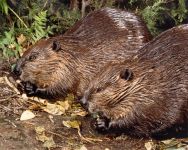


|

|
|
 
|
This is a list of a few publications that provide information on beavers, arranged alphabetically by first author. Listing a publication here does not mean that the Refuge necessarily endorses or agrees with anything mentioned. Be aware that much of the literature on beavers is by or from people who view the beaver as a resource or 'pest', with 'management' for human convenience or economic gain as a primary goal.
You can see more items on beavers in our Beavers in the News page.
The nature of the mosquito fauna in such impoundments can be of considerable interest to the associated human populations. The information presented here indicates that the presence of increased areas of impounded permanent water need not necessarily mean that larger pest mosquito populations will appear.
Drastic reduction of populations of univoltine temporary pool mosquitoes followed impoundment of breeding areas by beavers. Mosquito populations persist at very low levels over a 10-year period with no evidence of mosquito development in the impoundment.
A total of 55 beaver conflict sites were studied from 2000 through 2019. This first of its kind study revealed that the sites managed with nonlethal control methods cost significantly less than sites that were managed with beaver removal. In addition, nonlethal control methods provided millions of dollars of ecological services to the town annually that would have been lost with beaver removal.
Ecosystem services may include the abatement of dryland streams (Gibson and Olden, 2014), promotion of waterbird communities (Nummi and Holopainen, 2014), increase in salmon production (Pollock et al., 2004), and the removal of reactive N from the watershed as discussed herein.
From 1994 to 1999 we trapped and relocated 234 Beaver to 14 areas throughout Wyoming to improve riparian habitat and create natural wetlands. We attached radio transmitters to 114 Beaver and subsequently determined movements and mortality of release Beaver...Mortality and emigration (including transmitter failure) accounted for the loss of 30% and 51%, respectively, of telemetered Beaver within 6 months of release. ...2-3.5 year-old Beaver had higher average success (measured in days of occupancy at the release site) than older animals. Animals < 2 years old had 100% mortality and emigration losses within 6 months of release.
I trapped and transported 38 individuals to the nine release sites where dams constructed by beavers would benefit coho salmon productivity. All adult and sub-adult beavers were equipped with tail-mount transmitters. ... All radio-tagged individuals dispersed from their release sites. Survival 16 weeks post-release was 47%. Twelve of the radio-tagged beavers died within 90 days of release. Three cause-specific sources of mortality were identified including predation, natural causes, and human related. Mountain lions (Puma concolor) were responsible for the majority of predation based mortalities. Of the 38 nuisance beavers relocated, only five individuals contributed to the nine dams constructed post-release.
Whilst further research is required into the long term storage and nutrient cycling within beaver ponds, results indicate that beaver ponds may help to mitigate the negative offsite impacts of accelerated soil erosion and diffuse pollution from agriculturally dominated landscapes such as the intensively managed grassland in this study.